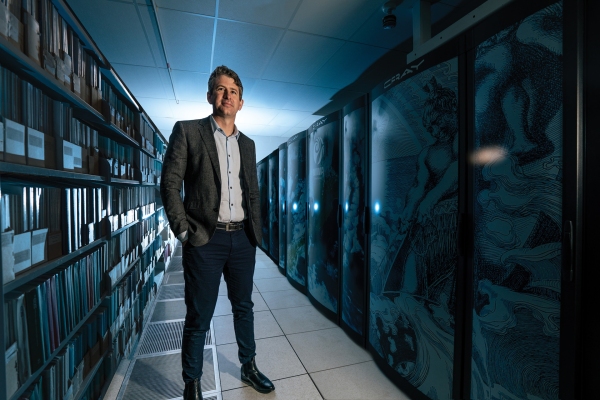Melissa Bray meets the geologist, with a strong sideline in maths, driving NIWA’s data science revolution.
Most days, Dr Jess Robertson jumps off the train and straps on his inline skates.
He is hoping the wind is at his back and he won’t have to battle the southerly to complete the commute to his Greta Point office.
That is about as ‘low tech’ as the Wairarapa resident’s working day goes.
Robertson is NIWA’s new Chief Scientist – High Performance Computing and Data Science.
His role is all about using the latest technology to drive NIWA’s science forward, and once he reaches the office, his world is consumed by machine learning, artificial intelligence (AI), data systems and supercomputing.
Robertson has long been interested in the relationship between systems and science. Originally from Dunedin, he studied geology and mathematics at the University of Otago before moving to Australia where he completed his PhD in geological fluid dynamics.
His introduction to machine learning and high-performance computing came when he joined the Commonwealth Scientific and Industrial Research Organisation, working between the Minerals and Data groups. Then came work with an Australian tech startup focused on data science opportunities with big resource companies, before he made the move back across the Tasman to lead science innovation policy at the Ministry of Business, Innovation and Employment.
Robertson now manages NIWA’s team of AI and deep learning data scientists and high-performance computing engineers. The data scientists are tasked with using machine learning, digital twin and computer vision systems, along with customised AI, to support NIWA’s research.
The Greta Point High Performance Computing Facility houses NIWA’s Maui supercomputer and provides the processing power needed to drive many of these systems. It plays a significant role in forecasting and climate science, but is also used widely across NIWA’s research platforms.
The move to NIWA, says Robertson, gives him the opportunity to 'get back on the tools' and he relishes the opportunity to bolt the power of fast changing technology on to research science.
“NIWA is uniquely positioned to bring together excellent domain science, coupled with state-of-the-art machine learning and data science. We’ve also got a good understanding of the end users of our science, whether they are communities, industry or government.”
Robertson says NIWA is already putting data science to practical use for those end users. He cites examples such as using computer simulations to enable higher resolution weather forecasting or river flood predictions using large computational models.
However, he believes there’s huge potential for data science to drive research further and make discoveries faster.
“The rate at which innovative new approaches are popping up has been nothing short of stunning.
“For example, five years ago machine learning was useful for problems that a 10-year-old could solve.
“Now, with some of the large language models like ChatGPT and stable diffusion methods for images, it’s not the work of 10-year-olds, it’s undergrad-level work that is being done.”
With change happening at lightning speed, Robertson sees the need to constantly re-evaluate the available technology.
“You might have looked at the use of AI five years ago and decided it’s not worth it, but you have to continually reassess.”
And that, says Robertson, is where the data scientists come in.
“It’s time to take a careful look and to connect the science we’re doing with the tools available. There’s already a lot of great ideas across NIWA which could be turbocharged with new approaches.
“The ability to bring in these rapidly changing tools from anywhere around the world and use them to do something cool, that’s what I want to build on.”
This story forms part of Water and Atmosphere - November 2023, read more stories from this series

